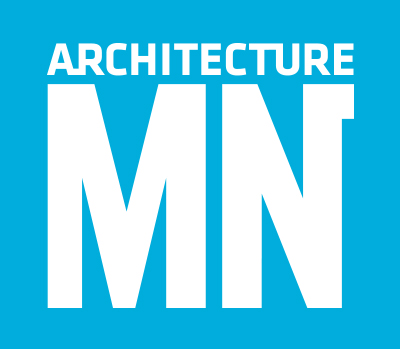How can a building be designed to serve the unique needs of Deaf people? A new residence hall at the Minnesota State Academy for the Deaf showcases the answers.
By Regina M. Flanagan
Wilkins Hall, the first new building on the Minnesota State Academy for the Deaf (MSAD) campus in Faribault in nearly 50 years, presented a not-to-be-missed opportunity to incorporate innovative DeafSpace design principles. Kodet Architectural Group, with Deaf architect John Dickinson of Dickinson + Partners, was tapped to design this student residence hall to embody Deaf culture and the ways that Deaf people inhabit their spaces.
Key to the design process was understanding that American Sign Language (ASL) is a visual and kinetic mode of communication—a physical language that occupies and animates space. Deaf people, when they gather, work together to customize spaces. They create a conversation circle so everyone is in clear signing range and can participate, and they adjust lighting to remedy conditions where backlighting or a shadow makes it difficult to see a signer’s face.
Customizing space to accommodate these practices is one of the archetypal patterns Hansel Bauman identifies in the DeafSpace Design Guidelines. Bauman, an architect and the cofounder and project director of the DeafSpace Institute at Gallaudet University—the world’s only university for the Deaf—developed the guidelines in 2010 with students and staff during a three-year research and design project.
MSAD, founded in 1863, provides educational services for Deaf, DeafBlind, and Hard of Hearing students up to 21 years old. Roughly 50 of the 110 students live on campus in one of three residence halls. Superintendent Terry Wilding grew up immersed in Deaf culture; he is from a family with nine siblings, and they and their parents are all deaf. Wilding joined MSAD mid-design and says his biggest challenge was communicating the Deaf perspective—to explain how the Deaf experience things.
“For example,” he says, through an ASL interpreter, “some think Deaf people hear absolutely nothing, but students with hearing aids and cochlear implants find noise and vibration from HVAC equipment particularly disturbing.” John Dickinson, who launched his architectural practice in 1999 and later worked with Bauman on projects at Gallaudet, brought his knowledge of the Deaf community and DeafSpace design solutions to the Kodet team. Together, the architects selected especially quiet mechanical systems for Wilkins Hall and isolated them to avoid acoustic interaction and vibration interference.
Kodet Architectural Group has designed nationally recognized schools for particular student populations, including the Hmong College Prep Academy in St. Paul and special-education program spaces for Minneapolis schools. The firm often works with student input; recognizing that Deaf students are visually oriented, they asked MSAD students to illustrate ideas. “We learned that they wanted more social spaces that feel like home,” says Ed Kodet, FAIA. “Through focus groups, we also discovered that students, alumni, and community members have special affection for older buildings on the campus, including Tate Hall and Noyes Hall, both by Clarence H. Johnston Sr. and on the National Register of Historic Places.”
Through dialogue with a range of academy stakeholders, the design for Wilkins Hall evolved to address five concepts that the DeafSpace Project describes as “touch points between Deaf experiences and the built environment”:
· Sensory reach: Clear sight lines and spatial orientation are especially important for people who are deaf or hard of hearing.
· Space and proximity: Deaf people generally need more space for conversation than hearing people.
· Mobility and proximity: They also benefit from wider circulation spaces, which allow them to sign while walking side by side.
· Light and color: Because Deaf people rely more on their eyes during communication, poor lighting conditions can easily lead to eye fatigue.
· Acoustics: Certain sounds and reverberations can be distracting or even painful for people who use assistive devices.
Wilkins Hall’s two-story entry hall has open sight lines from one end to the other—and out to the surrounding campus and nearby woods. Spacious enough to allow groups to gather and converse, the hall features a stone fireplace and a luminous, dichroic-glass aerial sculpture by Michele R Gutlove inspired by ASL and the native birds and fish at the nearby River Bend Nature Center. Strategic placement of windows and glass doors enables visual connections and extends sensory reach. Windows punctuate the second story, so residents upstairs can see down into the space. “Deaf people have the advantage of being able to communicate over distances,” says Wilding, “and the windows let us see and communicate with who’s here.”
Oriented north-south, the entry hall separates private and public spaces. To the east is a single-story wing with a classroom and an activity room. To the west, entered through a controlled access point, is a fireplace lobby leading to the first floor of a two-story, L-shaped dormitory wing. Wilkins Hall is flexible-use based on the number of students; currently, the first floor houses male students and the second floor female students.
Corridors are eight feet wide so that three or four people can converse at one time. Where the hallways and lobby meet inside the elbow of the L-shaped wing, there’s a “soft intersection”—window openings into a life-skills kitchen and a staff office extend sensory reach, allowing people in all three spaces to see who’s approaching from any direction. Other features include doors that open into the rooms, not into the hallway; recessed support columns and drinking fountains; and diffuse and programmable lighting.
The dormitory offers a range of units, from singles with a bathroom to single and double quads with a shared bathroom to apartments with separate bedrooms and bathrooms and a shared kitchen. If students in a quad want to talk, there’s space for them to rearrange furniture and gather. The apartments enable older students to develop independent living skills. “When a Deaf child is born, they are often the first Deaf person his or her parents have met, ever,” says Wilding. “The child may miss the simple things that parents talk about every day with their other children. Life-skills programs fill in those gaps, providing young adults the opportunity to learn to live on their own and be responsible for themselves.”
Display screens are everywhere—in the hallways, dorm rooms, even bathrooms. Most hearing spaces have an announcement or alert system; Wilkins Hall is piloting a visual communications system for the campus. The one major drawback to the system is the number of bulky cords it requires, says Wilding. The superintendent hopes to see options for a sleeker solution in the future.
The other technology in need of fine-tuning is the front-door security system. Currently, staff are notified of a visitor via a flashing light and bell, but they’re unable to communicate with that person. “Now it’s one-way communication, very much for hearing people,” says Wilding. “The person inside can see the one outside, but not vice versa. If it’s cold outside, the visitor might welcome a quicker response.”
DeafSpace design and universal design have similar principles and overlapping strategies. “Accessible design really does work better for nearly everyone,” says Kodet Architectural Group’s Daniel Kodet, AIA. But DeafSpace design, which grew out of Deaf people’s culture and ways of engaging with the world, has deeper intentions: to reinforce positive identity and empowerment. And that’s meaningful to the young Deaf students who call the new Wilkins Hall home.
MINNESOTA STATE ACADEMY FOR THE DEAF
WILKINS HALL
Location: Faribault, Minnesota
Client: Minnesota State Academy for the Deaf
Architect: Kodet Architectural Group, Ltd.
Principal-in-charge and project lead designer: Edward Kodet Jr., FAIA
Specialist architect: Dickinson + Partners
Energy modeling: The Weidt Group (now Willdan)
Landscape architect: HTPO (Hansen Thorp Pellinen Olson)
Construction manager: Knutson Construction
Size: 22,776 square feet
Cost: $8.2 million
Completion: August 2018
Photographer: Morgan Sheff
WILKINS HALL IS NAMED TO HONOR BLANCHE WILKINS, the first black woman to graduate from the academy, in 1893. Wilkins went on to become an influential teacher of black Deaf children and a life-long community advocate. At the building’s dedication earlier this year, Wilkins’ great-granddaughter Jan Stepto-Millet and great-great-granddaughter Maya Millet helped unveil a portrait of Blanch Wilkins Williams by Deaf artist Nancy Rourke.
TO LEARN MORE ABOUT DEAFSPACE DESIGN, check out Hansel Bauman’s TED Talk, “A New Architecture for a More Livable and Sustainable World,” and “DeafSpace: An Architecture Toward a More Livable and Sustainable World,” Bauman’s essay in Deaf Gain: Raising the Stakes for Human Diversity (University of Minnesota Press, 2014).


